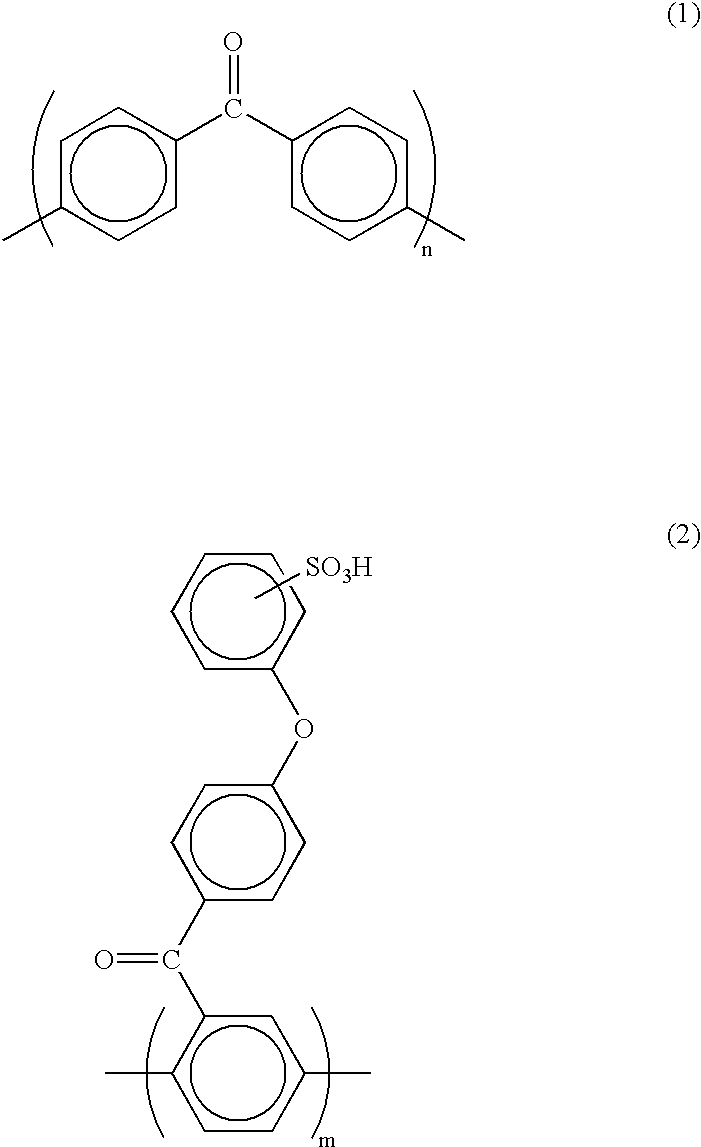Polymer electrolyte membrane and solid polymer electrolyte fuel cell using same
a technology of electrolyte fuel cell and polymer electrolyte, which is applied in the direction of non-aqueous electrolyte cells, cell components, sustainable manufacturing/processing, etc., can solve the problems of fossil fuels leading to global warming, oil reserves becoming exhausted, and the world of today is faced with grave environmental problems
- Summary
- Abstract
- Description
- Claims
- Application Information
AI Technical Summary
Benefits of technology
Problems solved by technology
Method used
Image
Examples
first embodiment
[0077] To begin with, there follows a description of the present invention.
[0078] In the first embodiment of the present invention the solid polymer electrolyte fuel cell employing a composite polymer electrolyte membrane has an membrane electrode assembly configured as illustrated in FIG. 1. This membrane electrode assembly has an oxygen electrode 1 and a fuel electrode 2, between which is a composite polymer electrolyte membrane 3. The oxygen electrode 1 and fuel electrode 2 each have a gas-diffusion layer 4 and a catalytic layer 5 formed on the gas-diffusion layer 4, and come into contact with the composite polymer electrolyte membrane 3 on the side nearer the membrane layer 5. The gas-diffusion layers 4 consist of carbon paper 6 and an underlayer 7.
[0079] In this membrane electrode assembly, the underlayer 7 is formed by coating one side of the carbon paper 6 with a slurry prepared by mixing, for instance, carbon black and polytetrafluoroethylene (PFTE) at a specified ratio by w...
second embodiment
[0460] There follows a description of the present invention.
[0461] A solid polymer electrolyte fuel cell which employs the composite polymer electrolyte membrane to which the second embodiment of the present invention pertains has an membrane electrode assembly which with the exception of the composite polymer electrolyte membrane 3 illustrated in FIG. 1 is exactly the same as the solid polymer electrolyte fuel cell to which the first embodiment of the present invention pertains.
[0462] There follows a description of the structure of the composite polymer electrolyte membrane 3 to which the second embodiment of the present invention pertains.
[0463] The composite polymer electrolyte membrane 3 to which the second embodiment of the present invention pertains has a matrix comprising a first polymer electrolyte selected from among polyarylene polymer sulfonates and having an ion exchange capacity of at least 1.5 meq / g but less than 3.0 meq / g, and a reinforcement comprising a second polym...
third embodiment
[0503] There follows a description of the present invention.
[0504] In the solid polymer electrolyte fuel cell employing a polymer electrolyte membrane to which the third embodiment of the present invention pertains, the polymer electrolyte membrane 3 in the structure illustrated in FIG. 1 is replaced with one comprising a single polymer electrode, apart from which the membrane electrode assembly is exactly the same as in the solid polymer electrolyte fuel cell to which the first embodiment pertains.
[0505] There follows a description of the structure of the polymer electrolyte membrane 3 to which the third embodiment of the present invention pertains.
[0506] The polymer electrolyte membrane 3 to which the third embodiment of the present invention pertains comprises a polymer electrolyte obtained by sulfonating a polyarylene polymer in such a manner that the Q value is in the range 0.09-0.18 C / cm.sup.2.
[0507] The sulfonated polyarylene polymer employed in the polymer electrolyte membra...
PUM
| Property | Measurement | Unit |
|---|---|---|
| wt % | aaaaa | aaaaa |
| wt % | aaaaa | aaaaa |
| mol % | aaaaa | aaaaa |
Abstract
Description
Claims
Application Information
 Login to View More
Login to View More - R&D
- Intellectual Property
- Life Sciences
- Materials
- Tech Scout
- Unparalleled Data Quality
- Higher Quality Content
- 60% Fewer Hallucinations
Browse by: Latest US Patents, China's latest patents, Technical Efficacy Thesaurus, Application Domain, Technology Topic, Popular Technical Reports.
© 2025 PatSnap. All rights reserved.Legal|Privacy policy|Modern Slavery Act Transparency Statement|Sitemap|About US| Contact US: help@patsnap.com



